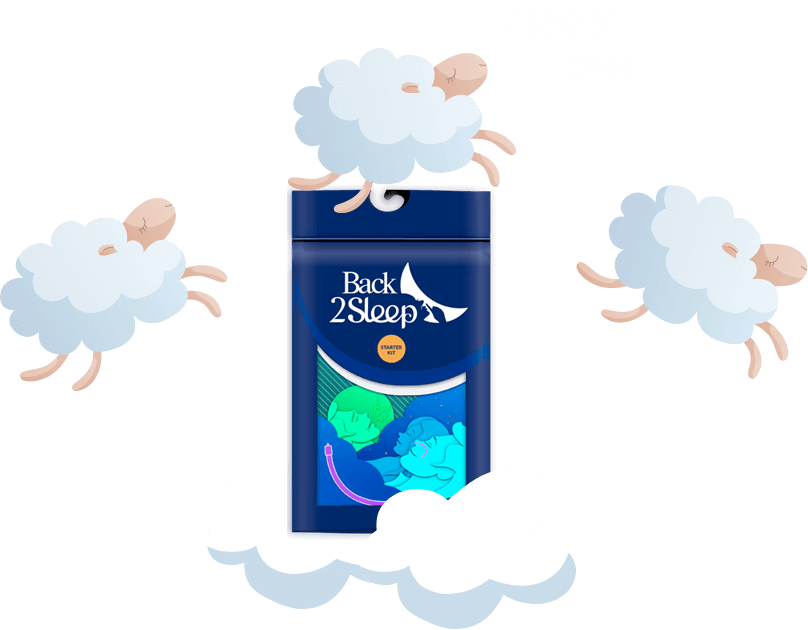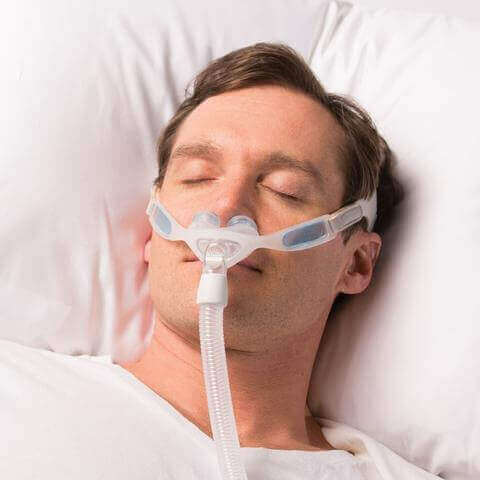Neusstukken: Complete gids voor CPAP-behandeling, advies & bijwerkingen
Ontdek alles over neusstukken voor slaapapneu - indicaties, juist gebruik, onderhoudstips en hoe bijwerkingen effectief te beheersen
Neusstukken bieden essentiële CPAP-therapie voor miljoenen mensen met slaapapneu, door continue positieve luchtwegdruk te leveren via kleine medische apparaten die in de neusgaten worden ingebracht om de luchtwegen tijdens de slaap open te houden. Deze uitgebreide gids behandelt juiste gebruikstechnieken, medische indicaties, mogelijke bijwerkingen en onderhoudsvereisten, en helpt u te begrijpen of een neusstuk bij uw behoeften past of dat alternatieve oplossingen zoals de Back2Sleep intranasale orthese mogelijk meer comfort en discretie bieden.
Een neusstuk is een klein medisch apparaat dat via een slang verbonden is met een CPAP-apparaat, voor de behandeling van matige tot ernstige obstructieve slaapapneu, hevig snurken en nachtelijke ademhalingsstoornissen. Het begrijpen van de juiste pasvorm, reinigingsprotocollen en het omgaan met veelvoorkomende bijwerkingen zoals neusirritatie zorgt voor optimale behandeleffectiviteit en minimaliseert ongemak tijdens uw slaaptherapie.
Snelle referentiegids: Overzicht neusstukken
| Belangrijke Punten | Samenvatting |
|---|---|
| Wat is een neusstuk? | Klein medisch apparaatje dat in de neusgaten wordt ingebracht, verbonden met CPAP-apparaat voor continue positieve luchtwegdruk tijdens de slaap |
| Beschikbare Typen | Wegwerp- of herbruikbaar, met/zonder ventilatie, met/zonder harnas, verschillende maten voor individuele morfologie |
| De juiste masker kiezen | Houd rekening met maat voor perfecte pasvorm, materialen voor comfort, ventilatieniveau, aansluitstijl en slaapgewoonten |
| Gebruik & Onderhoud | Dagelijkse reiniging met zeep en water, wekelijkse grondige reiniging, regelmatige vervanging elke 3-6 maanden |
| Voordelen | Discretie, bewegingsvrijheid, comfort, gebruiksgemak vergeleken met volledige gezichtsmaskers |
| Nadelen | Neusirritatie, luchtlekkage, congestiebeperkingen, mogelijk geluid tijdens gebruik |
Statistieken over neusstukbehandeling
Wat is een neusstuk en waar wordt het voor gebruikt?

Definitie neusstuk
Een neusstuk is een klein medisch apparaat dat in de neusgaten wordt ingebracht om slaapapneu te behandelen. Het is verbonden met een machine die continue positieve luchtstroom (CPAP) genereert via een slang, waardoor de bovenste luchtwegen tijdens de slaap open blijven om obstructies die apneu en snurken veroorzaken te voorkomen.
Hoe het neusstuk werkt
Het apparaat is via een slang verbonden met een machine die continue positieve luchtstroom genereert (CPAP). Deze positieve druk houdt de bovenste luchtwegen tijdens de slaap open, waardoor de obstructies die apneu-episodes en snurktrillingen veroorzaken, worden voorkomen.
Belangrijkste medische indicaties
Het neusstuk is voornamelijk geïndiceerd voor de behandeling van:
- Matige tot ernstige obstructieve slaapapneu (OSA)
- Zwaar snurken dat de slaapkwaliteit beïnvloedt
- Andere nachtelijke ademhalingsstoornissen zoals hypoventilatie
- Centrale slaapapneu in sommige gevallen
- Complex slaapapneusyndroom
Voordelen ten opzichte van andere behandelingen
Vergeleken met het volgelaatsmasker biedt het neusstuk:
- 💊 Discreter profiel en minder volume op het gezicht
- 💊 Betere tolerantie voor claustrofobische patiënten
- 💊 Makkelijker om een goede afdichting te bereiken
- 💊 Minder hinder bij lezen of tv-kijken
Het kan echter bij sommige patiënten neusirritatie of droogte veroorzaken, wat bevochtiging of alternatieve oplossingen vereist.
Welke soorten neussmaskers zijn er beschikbaar?
Wegwerpmaskers
Wegwerpmaskers gemaakt van flexibel siliconen. Ideaal voor reizen of allergieën voor herbruikbare materialen. Hygiënisch maar hogere kosten op lange termijn.
Herbruikbare maskers
Gemaakt van stijve materialen zoals plastic of gel. Wasbaar en geschikt voor langdurig gebruik. Vereisen regelmatig onderhoud maar zijn op de lange termijn kosteneffectiever.
Ventilatieopties
Modellen met ventilatiegaten voor uitgeademde lucht of volledig afgesloten waarbij de uitgeademde lucht via een buisgat wordt afgevoerd.
Variaties in banden
De meeste worden vastgemaakt met een verstelbare band rond het hoofd. Lichtere modellen klemmen direct op de neusgaten zonder banden voor minimaal contact.

Hoe kiest u het juiste neussmasker?
Maskermaat - Cruciaal voor succes
Een perfecte pasvorm stelt u in staat om de behandeling nuttig en relevant te maken. Maskers zijn verkrijgbaar in verschillende maten om te passen bij elke neusholtevorm.
Materiële Overwegingen
Sommige zijn gemaakt van zacht siliconen, andere van stijver plastic. De keuze hangt af van uw voorkeuren wat betreft pasvorm en comfort op de huid. Overweeg hypoallergene opties als u een gevoelige huid heeft.
Vereisten voor ventilatieniveau
Als u hoge luchtdruk nodig heeft, kies dan voor een masker met een gecontroleerd lek-systeem om vervelende lekken te voorkomen. Dit zorgt voor een constante therapiedruk gedurende de nacht.
Invloed van aansluitstijl
Maskers met hoge aansluiting (slang aangesloten aan de bovenkant) bieden meer bewegingsvrijheid dan modellen met vooraansluiting, wat vooral gunstig is voor actieve slapers.
Compatibiliteit met slaapgewoonten
Als u vaak van positie verandert, is een lichtgewicht, flexibel masker comfortabeler. Rugslapers geven de voorkeur aan goed gestabiliseerde modellen. Zijslapers hebben maskers met een minimaal profiel nodig om verplaatsing te voorkomen.
Gebruik en onderhoud van uw neuskussen
Stapsgewijze gebruiksinstructies
Sluit apparatuur aan
Sluit de luchtslang stevig aan op het neuskussen en het CPAP-apparaat
Positioneer het masker
Plaats de neustipjes in de neusgaten, zorg voor een goede afdichting zonder ongemak
Pas de pasvorm aan
Stel het hoofdbandje of de riemen rond het hoofd af zonder te strak aan te trekken
Start therapie
Zet het CPAP-apparaat aan en stel het voorgeschreven drukniveau in
Adem natuurlijk
Adem rustig door de neus om te profiteren van de luchtstroom
Ochtend Routine
Schakel het apparaat uit voordat u het masker verwijdert bij het wakker worden
Verzorgings- en reinigingstips
- Verwijder het masker elke ochtend voor dagelijkse reiniging met warm, zeepsop. Spoel grondig af
- Een keer per week alle onderdelen 30 minuten laten weken in een oplossing van heet water en witte azijn voor grondige desinfectie
- Droog het masker grondig voordat u het weer in elkaar zet. Vermijd blootstelling aan direct zonlicht, omdat dit de materialen kan verzwakken
- Vervang versleten onderdelen regelmatig zoals aanbevolen door de fabrikant, meestal elke 3 tot 6 maanden bij dagelijks gebruik
- Reinig de luchtslang wekelijks met lauw zeepsop en hang hem volledig te drogen voor het volgende gebruik
Voordelen en nadelen van neusstukken
Een van de kleinste en lichtste beschikbare, zeer discreet om te dragen
Minimalistisch ontwerp biedt veel bewegingsvrijheid tijdens het slapen zonder de afdichting te compromitteren
Weinig contact met het gezicht, vaak beter verdragen dan volledige gezichtshelmen
Eenvoudig ontwerp met weinig onderdelen maakt dagelijkse installatie en onderhoud gemakkelijk
Langdurig dragen kan droogheid, irritatie of neusbloedingen veroorzaken
Slechte afdichting leidt tot onaangename lekken en verminderde behandel efficiëntie
Elke neusverstopping verhindert effectief gebruik van het neusstuk
Sommige modellen veroorzaken hinderlijk gefluit of luchtgeluiden tijdens de nacht
Beheer van bijwerkingen en neveneffecten
Zoals bij elk neusapparaat kan langdurig gebruik van een neusstuk bij sommige patiënten bepaalde kleine bijwerkingen veroorzaken. Het begrijpen van deze effecten en hoe ze te beheersen verbetert de therapietrouw.
| Bijwerking | Frequentie | Beheerstrategie |
|---|---|---|
| Neusdrogenheid/Irritatie | Zeer Veelvoorkomend (30-40%) | Gebruik verwarmde bevochtiger, zoutoplossing neusspray, pas drukinstellingen aan |
| Luchtlekken | Veelvoorkomend (20-30%) | Verander de maat van het masker, pas de banden aan, controleer de afdichting, overweeg een ander maskertype |
| Drukplekken | Veelvoorkomend (15-25%) | Maak de banden losser, gebruik maskerlijnen, wissel drukpunten af |
| Neusverstopping | Incidenteel (10-15%) | Verwarmde bevochtiging, neusontstekingsremmers (met goedkeuring van arts) |
| Neusbloedingen | Zeldzaam (5-10%) | Verhoog de luchtvochtigheid, gebruik neusbevochtiger, verlaag de druk indien mogelijk |
| Claustrofobie | Incidenteel (10-15%) | Geleidelijke gewenning, ontspanningstechnieken, overweeg neuskussentjes |
De Back2Sleep Oplossing: Alternatief voor Traditionele Neussmaskers
In tegenstelling tot conventionele neussmaskers die CPAP-machines en slangen vereisen, biedt de Back2Sleep intranasale orthese een revolutionaire aanpak. De punt bereikt het zachte gehemelte om de luchtwegen van binnenuit open te houden zonder externe apparatuur.
Meer Vrijheid
Geen masker, slang of harnas om over het gezicht te dragen. Volledige bewegingsvrijheid tijdens het slapen.
Volledige discretie
Optimaal comfort voor een natuurlijke nachtrust. Vrijwel onzichtbaar tijdens het dragen.
Onmiddellijke effectiviteit
Effectief vanaf de eerste nacht volgens gebruikersgetuigenissen. Geen aanpassingsperiode nodig.
Goed verdragen
Behandeling met weinig impact goed verdragen op lange termijn. Geen elektriciteit of machines nodig.
💊 "Het heeft mijn nachten veranderd, een kleine investering maar echt effectief."
💊 "Mijn vrouw bedankt u, zeer goed product en 100% effectief vanaf de eerste nacht, geen gesnurk meer."
Aanpassingstijdlijn voor neusmaskergebruikers
Wennen aan het dragen van het masker, juiste pasvorm vinden, omgaan met aanvankelijke ongemakken
Verminderde bewustwording van het masker, betere afdichting bereikt, verbeterde slaapkwaliteit begint
Reinigingsroutine vastgesteld, bijwerkingen nemen af, consistent gebruikspatroon
Natuurlijk onderdeel van de slaaproutine, optimale drukinstellingen gevonden, maximaal voordeel behaald
Veelgestelde vragen over neusmaskers
Vind uw ideale slaapoplossing
Of u nu een neusstuk overweegt of op zoek bent naar alternatieven, een juiste behandeling verbetert uw slaapkwaliteit en algehele gezondheid.
Ontvang Persoonlijk AdviesAanvullende bronnen voor de behandeling van slaapapneu
Het begrijpen van neusstukken is slechts een onderdeel van het effectief beheersen van slaapapneu. Verken onze uitgebreide slaapgezondheidsblog voor het laatste onderzoek, innovaties in behandelingen en praktische tips voor een betere slaapkwaliteit.
Lees over onze missie om innovatieve slaapoplossingen te bieden die alternatieven zijn voor traditionele CPAP-therapie. Of u nu moeite heeft met het dragen van een masker of op zoek bent naar comfortabelere opties, wij helpen u graag om gemakkelijker te ademen.
Belangrijke medische opmerking: Hoewel neusstukken voor veel patiënten effectief zijn, zijn ze niet voor iedereen geschikt. Factoren zoals neusanatomie, ademhalingspatronen en de ernst van slaapapneu beïnvloeden het succes van de behandeling. Raadpleeg altijd uw slaapdeskundige om de meest geschikte therapie voor uw specifieke situatie te bepalen.
Onthoud dat succesvolle behandeling van slaapapneu inzet vereist en soms het proberen van verschillende oplossingen. Of het nu via traditionele CPAP-therapie met neusstukken is of innovatieve alternatieven zoals intranasale orthesen, het doel blijft hetzelfde: het herstellen van een gezonde, herstellende slaap voor een betere levenskwaliteit.








